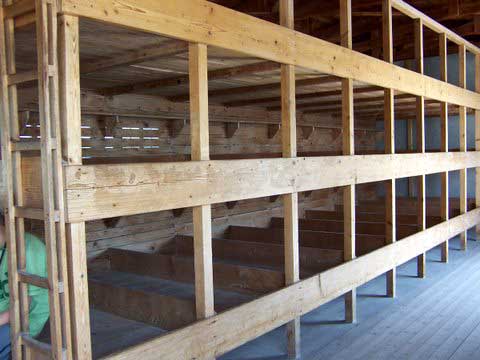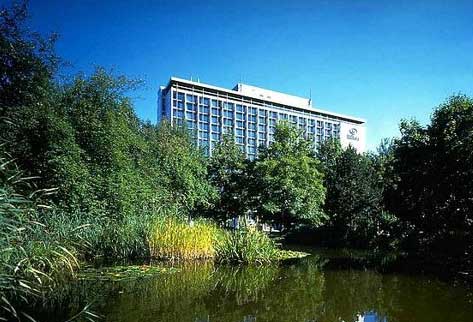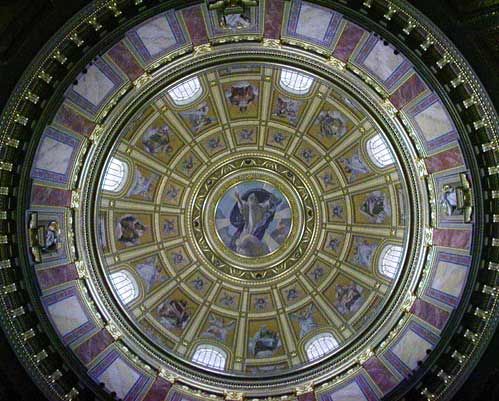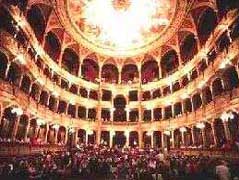|
Passport to the World over 64 years. Pages from my Travel Diary
A visit to Europe May 23-June 9, 2007 We basically wanted to take a 7 day River Boat cruise from Passau in Germany to Budapest in Hungary and return. At each end we would graft on a few days in Munich, and after the river journey fly back to Budapest for four days. On the internet we found Peter Deilmann Cruises in the US and a 7 day trip from Passau to Budapest and return in their river boat M.V. Casanova, we were able to book that for June 2-9, through a Sydney, Australia representative. The package we negotiated, included a 3 day stay at the Hilton on the Park in Munich, a half day tour of Munich, and transfers to Passau, some 2 hours by car, and from Passau to Munich airport on our return. By air Sydney/ Abu Dhabi/ Munich and return with Etihad Airline. We drove to Sydney a few days before our departure date. All liquids in carry on Luggage to be displayed in a clear resealable plastic bag 20mm by 20mm. On long hauls to Australia Etihad are using the Airbus 340-500. The seating which we found rather narrow and with sharp projections, by the use of several buttons converted into a lay down cocoon type bed. Each was fitted with its own screen for showing movies etc, controlled by a handset full of buttons, it stowed in a slot in the seat arrangement, and at just the right place and height for my elbow to operate without any intent on my part. I was often imploring cabin staff to switch the wretched thing off for me. Using the toilets. Food served in flight. Abu Dhabi Airport. Munich loomed up at about 6.30 AM on Wednesday May 24, no problems with immigration, and to our relief our two cases appeared on the luggage roundabout. A taxi to The Hotel Hilton on the Park, being close to the rather lovely English Gardens, one of Germany's larger city parks. Although very early, the Hotel had our room ready by 10 AM, we showered and collapsed into a comfy bed for some time. After rising we took a bus and the Metro underground to Marienplatz, in the city centre, and had no problems in finding our way around, we had visited Munich earlier in our travels. Thursday May 24, 2007. We take ourselves on a visit to Dachau, the former concentration camp. We had no problems at all arriving at Dachau, now sponsored by a Jewish group, as The Dachau Concentration Camp Memorial Site, and made available free to the many thousands who visit each year. On March 22, 1933, just a few weeks after Adolf Hitler was appointed Reich Chancellor, a concentration camp for political prisoners was set up at Dachau, serving as a model for all later concentration camps and a school of violence for the SS men under whose command it came. Over its twelve years of operation some 200,000 people drawn from all over Europe were imprisoned, and more than 43,000 died here. The survivors were liberated by American troops on April 29 1945. The only entry was the Jourhaus, set in the middle of this gate " Work sets you Free." The roll call area is covered with small stones, here the prisoners were forced to line up both mornings and evenings, to be counted and often had to stand motionless, should a prisoner be missing such as after an attempt to escape, this roll call agony could last for hours. There were 17 barracks or blocks on both sides of the camp road, on the right side was the Sick Bay with its death chamber, during WW2 was extended from 2 to 13 barracks, in blocks 1, 3 and 5, the SS carried out horrific medical experiments on selected prisoners from 1942 onwards.
Each barrack was divided into four, comprising a day room and dormitory, designed to hold 200 prisoners, towards the war's end up to 2,000 prisoners were herded into each barracks. The original barracks in 1964 were torn down because of their dilapidated condition, and both of the first barracks were rebuilt. The crematorium was built by the SS in the summer of 1940, it was located outside the prisoner camp, and in 1942/1943 a second large crematorium known as Barrack X, with 4 furnaces and a gas chamber for mass extermination was built, but it was never commissioned. However, executions and murder operations were still carried out in the original crematorium. The Theatre and Museum. An interesting Museum had a range of photos and documents on show depicting all aspects of this concentration camp in full operation. International Memorial. The Camp Fencing. Conclusion. The Munich English Gardens. We walked its shady gravel paths to the Chinese Tower, wrecked by Allied bombing in 1944, but rebuilt later, the beer garden close by can cope with 7,000 seated, many of whom brandish large litres of beer. A 2 Euro deposit is charged on each glass beer container, thus saving staff from collecting empty glasses, one takes back the empty container to redeem the deposit. We walked here at dusk one evening for a meal and shared a roast chicken. Lily ponds and water sites are a great attraction, and our visit to Munich was enhanced by the close proximity of these delightful gardens.
Drive to Passau to board M.V. Casanova.
We had a great deal in common, and Denise and Annie hit it off, she was a very witty and funny lady, and the four of us enjoyed our time together on the Danube. Passau sits on the border with Austria, 150 kilometers NE from Munich, on the confluence of three rivers, the Danube, Inn and Ilz. It is an ancient city originally a Celtic settlement, named Baiudurum, then a Roman military camp Castra Batava. In 739, Saint Boniface founded the Bishopric of Passau and the town prospered being ideally located for trade etc. Today it has a population of some 50,000 and housed in St Stephens Cathedral is the world's largest church organ. On our arrival at about noon at Passau, we stopped at dock No 13 where the Cassanova was supposed to be, just an empty space. We found out that the ship was delayed and unlikely to arrive before 8. 30 PM, Neil promptly telephoned the ship, got in touch with its Hotel Director, Mario, and demanded we be provided with two hotel rooms and dinner, of course at the ship's expense, all quickly agreed to by Mario. In due course after a rest in our Hotel room we walked to St Stephen's cathedral along ancient cobbled streets, its lofty bell tolling, calling its parishioners to evening Mass. Churches, Cathedrals in Germany are old by Australian standards, they were build to last, and when their age is considered one just wonders how they were constructed without the use of modern building aids we enjoy today. This cathedral along one wall houses the world's largest church organ, a work of art in its own right.
M.V. Cassanova arrives. Cabins on the upper deck where ours was located had full length French Doors opening into the cabin, two single beds, built in robes, fitted with television, refrigerator, personal safe and hairdrier, which oddly enough was secured in a drawer of the desk, and could be withdrawn only a limited distance. A reasonable bathroom with toilet, basin and shower and lots of fluffy towels and plenty of hot water completed our cabin facility. The Dining Room beautifully fitted out, and the staff very attentive, our Waiter, Christo did a great job of looking after Denise, Annie, Neil and myself. The menu always elaborate, and the courses, up to nine of them on special nights were served attractively. No complaints at all! The lounge with its bar and comfortable seating was the venue for two nights of entertainment, the first violin and conductor of the Bratislava Symphony Orchestra, he played the piano, gave us a feast of wonderful music, and on a second night we enjoyed a violin, piano and lady singer. Cruising down the Danube. Hydroelectric plants along the Danube and a difference of some 206 metres in elevation between Passau and Budapest necessitate the negotiation of some 11 locks over a journey of 579 kilometers. Durnstein. We pressed on to Budapest in Hungary for a 10 hour stop. Budapest. Tuesday May 29th. Bratislava/Slovakia. Bratislava is the capital of Slovakia, the right hand bit that was once part of the old Czechoslovakia, on January 1st. 1992 the country split into the Czechoslavkian Republic and Slovakia. The Hungarians called it Pozsony, the Germans and Austrians used the name Pressburg, In 1537 Pozsony was the capital of Hungary not held by the Turks, and it became a Hungarian coronation city, in 1918 when the Hapsbury monarchy ended the city was renamed Bratislava, it had been the capital of Hungary for some 258 years. We went off on the city walk, picked up a bus to wind up narrow streets to the castle ( Hrad ) sitting high above the city, a great view of the surrounding country side and as always, the ever present majesty of the mighty Danube. A walk through the restored city centre, narrow cobble stoned streets with an occasional gold crown set flush in the road to mark the Royal Coronation route to St Martin's Cathedral where Hungarian kings were once crowned. At Primatial Square a wonderful 18th. century building, the former home of the archbishops of Esztergom, now housing works of European painters and a display of Gobelins tapestries from the 17th. century. An interesting old city steeped in history of the time of the Hapsburg rulers. We set off once more and Vienna beckons. Vienna, 30th. May and 31st. of May. This is the longest stop that M.V. Cassanova will make over our week in her, this must be the 4th. or 5th. time we have visited Vienna, the capital of the Republic of Austria. It is a beautiful city with some 1.6 million inhabitants, regarded as the political, economic, intellectual and cultural centre of Austria. The Coffee House. Wednesday May 30th. We left the ship, walked to the local Metro, and took the underground for four stops to alight alongside the huge St Stephen's Cathedral, we now had our bearings. This Cathedral consecrated in 1147 sits as a city land mark, the top of its tall south tower is reached via 345 steps, a long and arduous ascent. This imposing structure carries a steeply pitched roof with zigzag tiling, devasted by bombing in WW2, but it was finally restored to dominate the landscape. We walked the pedestrian mall but soon sought shelter in a Coffee House we had visited in our earlier times in this vibrant city, to partake in apple strudel and Viennese coffee. We had little incentive to leave its warm embrace, but finally ventured out into the biting wind to grab a taxi and go back to our ship. Thursday May 31st. She now sailed away from Vienna the next and last stop on the Danube to be at Melk also in Austria. Benedictine Abbey Melk. Only two years later fire again swept the complex, which was once more rebuilt. Today only 15 monks live and work here, but the Abbey houses a school for 800 students, for both girls and boys. The truly magnificent library carries 80,000 books and 2,000 manuscripts, the beautifully painted ceiling gives the impression of having curved ends, in fact it is an illusion, the ceiling is quite flat. Exiting the library you traverse down a spiral staircase to enter the church, it is quite breathtaking with a wonderful altar, a golden pulpit. This is no ordinary chapel but a soaring creation truly in the Baroque style. Naturally you leave this inspiring church via the gift shop, there is no escape. The view of Melk nestling at the foot of this Abbey high on its rocky outcrop is like something out of a fairy tale book as the Danube beckons below. We return to our River boat to continue our journey back to Passau. It has been a week of discovery and wonder, we thought that a week might be too long and time hang on our hands, but no, its all over too soon and we could well have enjoyed 14 days on the Danube. Back at Passau. Budapest the Pearl in Hungary's Crown. This fair city sits both sides of the Danube, looking up stream, Pest is on the right side of the river, and Buda occupies the far bank of the Danube. Corinthia Grand Hotel Royal. A nice way to start, and one appreciated. The entrance lobby, the grand staircase etc quite a sight. I was able to use free broadband in the Executive Club. Money in Hungary. Some brief history of Hungary. In 1867 a dual monarchy was established, and the separate entities of Buda and Pest merged to form Budapest the capital. The Austro-Hungarian Empire, Hungary was on the side of Germany in WW1 with a poor result, WW2 was equally bad, occupied by German troops in 1944, to fall to the Soviets in 1945, at that time only one in four of the city's buildings were still intact. Now Hungary was part of the Austro-Hungarian Empire and in WW1 supported Germany with dire results. WW2 proved equally as bad, occupied by Germany in 1944, to fall the next year to the Soviets, when 25 % of the buildings are still intact. Hungary now becomes a Soviet Satellite, experiencing nationalisation. In 1956, an uprising brings a new administration under Janos Kadar hoping to improve economic conditions, and to relax political severities. In 1989 Hungary pushed aside the Iron Curtain and embraces democratic goivernment and a free economy. Some of the Sights. Now its more 19th. Century neo-Gothic, grafted onto what the Turks left behind of the original building in 1686. Nearby the Fisherman's Bastion rises with white ramparts, gargoyles, cloisters and towers, built on the site of a once medieval fish market, the arches frame the views of the Danube and snapshots of Pest as you look to the west. There is a cost to visit this area, and photograpers run riot here, and Mr Kodak must rue the day that the digital camera spelt the death knell of his film business. The Chain Bridge dominates the scene as it brings both Pest and Buda together, we descend from the Castle prestinct by a funicular built in 1870, then taxi back to our hotel. St Stephen's Basilica.
Metro. We rode the length of a fine Boulevard Andrassy Ut to reach the end where one finds Heroes Square, topped by the statue of the Arch angel Gabriel, it was begun on the 1000th. anniversary of the Magnar conquest, it depicts Prince Arpad with his chieftans enclosed in a colonade of Hungarian leaders from King Stephen to the 1848 revolutionary Kossuth. A night at the the Hungarian State Opera House. A beautiful building built in the traditional curved four tiers, elaborate boxes, and a lovely painted ceiling, but the seats ancient and very hard on one's behind. Built between 1875-1884 this Opera house seats 1,261.
There is no air conditioning. The facade features statues of prominent composers, they were renovated in 1966; these represent from left to right : Monteverdi, Scarlatti, Gluck, Mozart, Beethoven, Rossini, Donizetti, Glinka, Wagner, Verdi, Gounod, Bizet, Moussorgsky, Tchaikovsky, Moniuszko and Smetana. Tosca was sung in Italian, with Hungarian sub titles, now Hungarian must be one of the hardest languages in the world to learn and speak if not a native Hungarian. There is no way one can even guess at the meaning of a single word, so sub titles were no use whatsoever. We did enjoy the music, and the lovely atmosphere of a full house, an interesting note, the cast took a bow after the end of each act, rather than at the actual end of the performance. Audience members who had brought flowers, finally rushed up to the stage to lay them there, a memorable night and fitting finale to our stay in this Paris of the East. Homeward flights. From the Hotel Web Site: Architect Helmut Jahn, who has placed his imprint on many cities in this country and abroad through his buildings, e.g. in Berlin with the Sony Center and in Bangkok with the Suvarnabhumi International Airport, designed this airport hotel as a residence where high tech and nature embrace - both inside and out. A place where spatial limits disappear in the glass-covered openness of a luxurious atrium dotted with palm trees as if in a world of dreams, drawing one’s view into the far distance. Through special lighting technology, an extraordinary atmosphere with changing themes and colours is produced at night. Guests are inspired ever anew or are simply able to relax in marvellous ways. As soon as you enter the building through the main entrance you feel the splendour of the grand plaza, a 24-high meter high and 1400 square meter large atrium hall with a glass roof, flooded with light. Palm trees (18 meters tall) flown in from California ensure a fascinating moment of arrival, inviting you into an oasis of tranquillity. Green cubes and grown-over pyramid shapes continue the outer landscape surrounding the airport. It commences outside, continues through the atrium and comes to an end outside again. Transport from Terminal 2 to Terminal 1. Off to Abu Dhabi. The First Class/Business Class desk was unmanned, and the transfer desk was under seige by about 60 customers clamouring for attention. An Etihad staff member said join the queue, as Business Class passengers who had paid quite a premium on Economy we expected a modicum of service, and fronted up at the desk, to be generally ignored. We had landed at 8.30 PM, and it took until after 11 PM for us to arrive at a city hotel after going through immigration, and waiting for the car to transport us some 35 minutes. We are giving you a suite the desk staff said, WELL, it was 34 degrees C, the suite airconditioning did not work, the phone did not work, the refrigerator in the kitchinette totally empty, not a cold bottle of water. Not a single glass in the room. We stumped back to the desk, to get the airconditioning running, and ask for a bottle of cold water to be sent up, all smiles at the desk, no water ever arrived. The engineer eventually got the air coinditioner working, the 6.15 AM morning call could not be delivered, as the phone did not work. Did a staff member knock on our door? Not likely. Being conscious of an early start for the airport in the morning, Denise had no sleep I dozed but briefly. The next morning a quick and meagre breakfast and off to the airport, and a 16 hour haul to Sydney to arrive at 6.30 AM on Saturday June 9th. Rain and more rain. After clearing Immigration, and with a sigh of relief grabbing our two cases, we were subjected to an X-Ray of our cases. We eventually were found by Mark, to get drowned getting to his car, our holiday was certainly over, and the rain tumbled down all week end. Conclusion. A few days in Sydney and we took off for Melbourne by car, stopping overnight at the country town of Wangaratta to awake in the morning to the car windscreen and windows covered in a deep frost, from a Northern summer to a Southern winter in the space of a few short days. We drove home to our Melbourne apartment, as always its good to be home. Where to next? At the moment that can only be conjecture.
|






